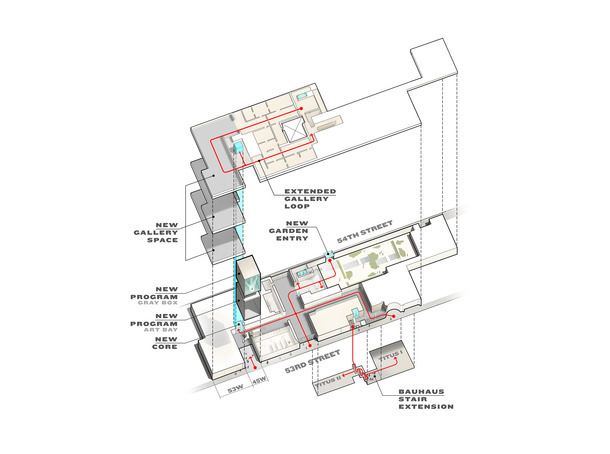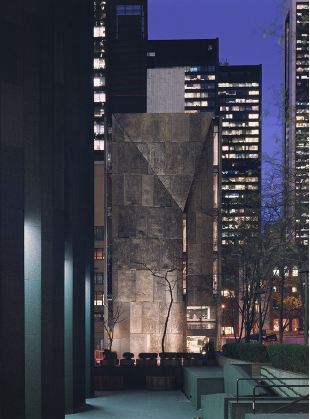Vanessa Quirk reports for Archdaily.

In a statement released last night, Glenn Lowry, the director of the MoMA, confirmed that the American Folk Art Museum, designed by Tod Williams and Billie Tsien Architects, will be demolished in order to make way for a re-design and expansion spearheaded by Diller Scofidio + Renfro (DS+R).

In his message Glenn Lowry states:
“The plans approved today are the result of a recommendation from the architects [Diller Scofidio + Renfro, the renowned interdisciplinary studio based in New York City], after a diligent and thoughtful six-month study and design process that explored all options for the site. The analysis that we undertook was lengthy and rigorous, and ultimately led us to the determination that creating a new building on the site of the former American Folk Art Museum is the only way to achieve a fully integrated campus.”
The new design, which should add about 40,000 square feet of new galleries and public areas and address MoMA’s considerable congestion problem, will integrate the current building with two sites to the west of the Museum: three floors of a residential tower, designed by Jean Nouvel, at 53 West 53rd Street, as well as the site of the former American Folk Art Museum.
The new design by DS+R features an expanded first floor and Sculpture Garden, which will both be open to the public for free; an upper floor that will contain more galleries and space for performance art; as well as many new access points and passageways to improve traffic flow.
Critics, however, although generally understanding of the MoMA’s need for space, as well as Diller Scofidio + Renfro’s analysis of the site, remain decidedly critical of the MoMA’s decision for two major reasons: (1) the expansion still remains insufficient in terms of space (meaning much of the collection will still remain in storage); and (2) the demolition of the 3-year-old Folk Art Museum, an architectural gem for New York City, would be deplorable in any circumstances – at the hands of a reputed cultural institution such as the MoMA, it is almost unfathomable.
Jerry Saltz, writing for Vulture, writes a heart-felt condemnation of MoMA – not so much for the demolition of the Folk Art Museum – but for the shortsighted and commercial nature of the expansion:
“It’s a lot like the last expansion plan. Only this one is even more snazzy, with a lot more glass — sorry, “transparency to the street “— and spaces designed primarily so people can look at other people looking at other people looking at people. […] All this avoids MoMA’s basic problem, which I’ve written about before: that the museum needs to triple the amount of space for showing its permanent collection of art made before 1980. It didn’t in 2004, and it isn’t now. […]
It kills me to write this, because I’ll be visiting MoMA for the rest of my life, but I […] will never get to see its incredible collection shown properly. Good-bye, MoMA. I loved you.”
Justin Davidson, also writing for Vulture, empathizes with DS+R’s ethical and architectural conundrum (what’s worse: to demolish Folk Art or scar it forever?); however, he contends that the resulting design remains “halfhearted”:
“By the time the architects were done tinkering with their old friends’ creation, it would have been so bastardized that there was little point in keeping the remains. In an architectural version of the battlefield paradox, DS+R would have had to destroy the building in order to save it. But that hesitancy shows in the provisional design for the next phase.
The client is bent on art-world domination; the architects seem halfhearted. Instead of healing the scar left by the Folk Art Museum, they have left a gleaming gap. […] It’s possible that as the architects refine their work, MoMA will receive a similarly rejuvenating spa treatment. Maybe seeing the Picassos will get more pleasant, and the whole complex will shed its cold, corporate air. But for now the design feels less like an optimistic hosanna than a mournful chorus of compromises.”
Paul Goldberger of Vanity Fair, in a characteristically eloquent article, focuses on the tragedy of losing the Folk Art Museum – not just for MoMA, but for New York City as a whole:
“Lowry envisions the expansion as a way of creating much needed breathing space. ‘We are a victim of our own success,’ he told me. Fair enough. But this argument, however much it responds to a real problem, reminds me a bit of the highway engineer’s practice of solving traffic problems by building more freeways. As we have learned the hard way, more roads generally bring more traffic, perpetuating, rather than fixing, the problem.
Yes, MoMA lacks the space to show enough of its great collections, and yes, it long ago lost the domestic scale that made it, once, the most beloved of all of New York’s major museums. Is there a way to fix the first problem without making the second one even worse? […]
The brooding, somber façade of the folk-art museum, made of folded planes of hammered bronze, combines monumental dignity with the image of delicate handcrafting, and it is a majestic, if physically small, architectural achievement. A city that allows such a work to disappear after barely a dozen years is a city with a flawed architectural heart. A large cultural institution that cannot find a suitable use for such a building is an institution with a flawed architectural imagination.
The Williams and Tsien building is also the last remnant of something approaching reasonable scale on West 53rd Street, a block that seems ever bigger, ever more corporate, ever less diverse. Tearing down the folk-art museum may make sense by MoMA’s measure of things, but it is hard to see how it makes New York a better place.”
Michael Kimmelman of The New York Times took to Twitter to express his disappointment.
American Folk Art Museum, by Tod Williams Billie Tsien Architects.






